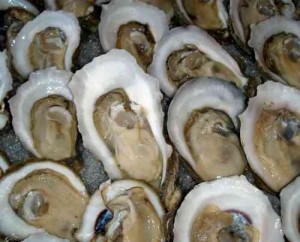I don’t eat raw oysters.
Lifelong Brisbane residents I know will not eat oysters, raw or cooked (and we have an abundant supply — of oysters, and lifelong Brisbane residents).
 JoNel Aleccia of The Seattle Times writes that when a work trip sent Jill Poretta to Seattle two summers ago, the New Jersey resident decided to make a vacation of it, a chance to see the sights and enjoy the city’s fine dining.
JoNel Aleccia of The Seattle Times writes that when a work trip sent Jill Poretta to Seattle two summers ago, the New Jersey resident decided to make a vacation of it, a chance to see the sights and enjoy the city’s fine dining.
But an appetizer plate of mixed oysters soon spoiled the trip. The day after her dinner at a restaurant on the central waterfront, Poretta became so violently ill she had to take a cab to a hospital at 3 a.m.
“I couldn’t get out of the car,” recalled the 43-year-old legal researcher from Haddonfield, N.J. “I’m vomiting as soon as I walk in the door.”
Poretta had to cut short her trip and head home, where she says she felt exhausted and ill for two weeks. Tests showed she’d contracted Vibrio parahaemolyticus, known as Vp, a leading cause of seafood poisoning in the U.S.
In July 2013, her case was one of four traced to Hammersley Inlet, an arm of water in southwest Puget Sound. State health officials closed the shellfish-growing area — but only after Poretta and others had gotten sick.
Starting this month, there’s a new approach — a first-in-the-nation effort by state health officials and shellfish growers — to curb heat-loving Vp long before it hits the plate. It requires quicker cooling of oysters when air and water temperatures get too warm and closing at-risk commercial beds before illnesses occur.
The protocol requires real-time monitoring to determine how fast harvested oysters must be cooled to a safe 50 degrees — and when they shouldn’t be gathered at all.
The rules aims to reduce the 40 to 45 infections tied to Washington oysters that are confirmed each year and another 6,000 to 7,000 cases that go undiagnosed, health officials said.
“Anytime you’re basically waiting for illnesses to trigger an action, it means you’ve missed your peak window for public-health protection,” said Laura Wigand Johnson, a marine and environmental scientist who led the state’s two-year process to put the Vp procedures in place.
But the new strategy, which took effect May 1 and runs through Sept. 30, has sent ripples of concern through Washington state’s commercial shellfish industry. That includes 329 licensed private growers and 39 tribal producers, though only about 150 deal in oysters, Johnson said.
All say they are in favor of reducing hard-to-predict Vp illnesses, even as they acknowledge the move requires new duties, new documentation and extra staff.
“It’s quite a shift in the way we do business as it relates to oysters for raw consumption,” said Bill Dewey, a spokesman for Shelton-based Taylor Shellfish Farms, the largest producer of farmed shellfish in the U.S. “We’re working through the nuts and bolts of how we do it.”
Those nuts and bolts apply to shellfish harvesters and dealers who supply fresh oysters to market to be eaten raw, not oysters designated for shucking or post-harvest processing.
There’s lots more at http://www.seattletimes.com/seattle-news/health/tighter-rules-aim-to-limit-seafood-poisoning-from-raw-oysters/
